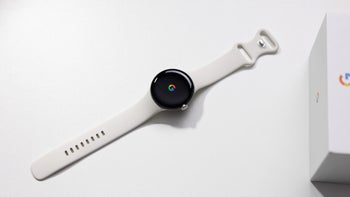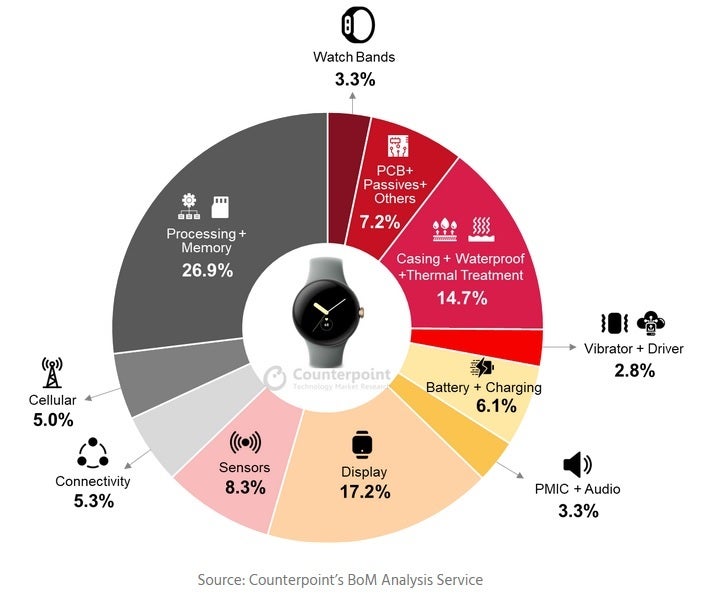The Pixel Watch may be branded Google but its bill of materials says "Samsung"

As the Pixel ecosystem continued to expand, the Google Pixel Watch was released on October 13th and is priced at $349.99 for the Bluetooth model and $399.99 for the LTE variant of the timepiece. According to Counterpoint Research, the bill of materials (BoM) cost of the LTE-compatible Pixel Watch is estimated to be $123. Counterpoint points out that Google uses a high-performance processor that can handle the latest version of Wear OS.
The chip used to power the Pixel Watch is an Exynos 9110 which is built by Samsung Foundry using the latter's 10nm process node. The component features a dual-core CPU which consists of ARM's Cortex-A53 CPU running at a clock speed of 1.1GHz, a Mali-T720 GPU, and an LTE Cat.4 modem. The co-processor consists of NXP‘s MIMXRT595S which uses ARM's Cortex-M33-based MCU (microcontroller) with a digital signal processor and GPU cores.
The category of parts for the Pixel Watch that costs the most belongs to Processing + Memory
The cost of the two processors and the Kingstone 32GB+2GB ePoP embedded memory chip accounts for nearly 27% of the BoM, or $33.21 for each Pixel Watch. The Gorilla Glass 5 protected display makes up 17.2% of the BoM or $21.16. The 1.2-inch OLED Always-on display made by BOE has a 450 x 450 resolution and can produce a bright 1000-nit image allowing users to see their timepiece even during sunny days.

Breaking down the bill of materials for the LTE Pixel Watch
For the cellular model, the Pixel Watch uses an LTE Cat 4 setup. The report states that this is made up of Samsung's S915 transceiver, Skyworks' SKY53737 diversity receiver and SKY77643 multi-mode, multi-band power amplifier module, Qorvo’s antenna switch, and multiple duplexers from muRata. Also in this category, you'll find Broadcom's Wi-Fi/Bluetooth combo, the BCM430132, the company's standalone GPS chip (BCM47765), and STMicroelectronics' NFC chip which supports eSIM and Google Pay.
Cellular-related parts make up 5% of the materials and cost $6.15 per timepiece; the other connectivity-related parts cost Google about $7.01 for each unit or 5.7% of the total BoM cost.
As you might expect, there are a few sensors on the Pixel Watch. Some handle the operations of the device including an ambient light sensor and the light encoder for the digital crown. Other sensors track health data including some from Texas Instruments used to track a user's heart rate and to conduct an electrocardiogram (ECG). The sensors combine to make up 8.3% of the BoM or $10.21 per watch.
Other parts of the Pixel Watch include:
Casing + Waterproof+ Thermal treatment-14.7% or $18.08 per watch.
PCB (Printed Circuit Board) + Passives + Others-7.2% or $8.86 per watch.
Battery + Charging-6.1% or $7.50 per watch.
Watchbands-3.3% or $4.06 per watch.
Counterpoint says that the biggest winners from the Pixel Watch supply chain are Samsung (which supplies the main chipset, LTE transceiver, and other parts) which is responsible for supplying 20%, or $24.60 in parts for each Pixel Watch. BOE, which supplies the device's display, is next as it collects about 14% of the BoM cost ($17.22 for each unit).
Samsung's parts make up 20% of the BoM cost of each Pixel Watch
Keep in mind that the BoM doesn't include the cost to Google to assemble the product, package the Pixel Watch, market the device, and distribute it. So you cannot conclude from this data that Google is making a huge profit on each LTE variant of the Pixel Watch sold.
Counterpoint says that compared to the category-leading Apple Watch, there is plenty of room for improvement. The research firm says that through Google's partnership with Samsung, "Google is likely to empower its next-generation Pixel Watch with a more powerful, integrated, intelligent and secure processing platform."
The Pixel ecosystem will be growing later this year with the expected release of the Pixel Tablet. And a foldable device will probably still be launched sometime later this year adding a new form factor to the Pixel line. We could see the mid-range Pixel 7a introduced at Google I/O 2023 (most likely to be held in May) and released later this year. And of course, the Pixel 8 and Pixel 8 Plus will most likely be introduced and released during the fourth quarter.
When will we see the Pixel Watch 2? Right now our best guess is that a quick preview of the watch could be shown at Google I/O. The Pixel Watch 2 could be officially announced and released this coming October.














Things that are NOT allowed: